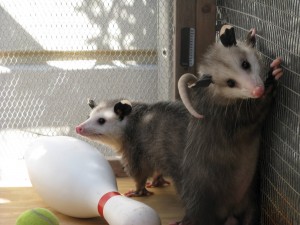The next time you are strolling through Carolina Wildlife and pass Sonny and Cher opossum, stop to appreciate what a rare beast you are viewing. Pshaw! you protest, it seems you can’t drive 2 miles in North Carolina without seeing a deceased opossum by the road.

Although very numerous as individuals, the Virginia opossum is a taxonomic rarity. Didelphis virginiana is in fact the only species of marsupial that exists north of the Rio Grande river. Originally found in the Southeast only, the opossum was spread by humans to the west and north during the early 20th century.
Mammals are usually divided into three groups: the monotremes (the egg laying mammals), the marsupials (pouch bearing mammals), and the placentals (mammals with internal development). The marsupials get their name from their distinctive pouch called a marsupium. In contrast to placental mammals, marsupial babies are born underdeveloped (4-5 weeks of age) and must crawl from the opening of the birth canal up and into the pouch where they attach to a nipple and continue to grow. As the offspring develop they may venture out of the pouch for short periods as they become more independent.
The distribution of the three groups of Mammals is an interesting study in biogeography. Why do you think marsupials are the dominant group of mammals in Australia while placentals are the dominate mammalian fauna on every other continent? Why would there be over 100 marsupial species in South America, about a dozen in Central America, and only one in North America north of the Mexican border?